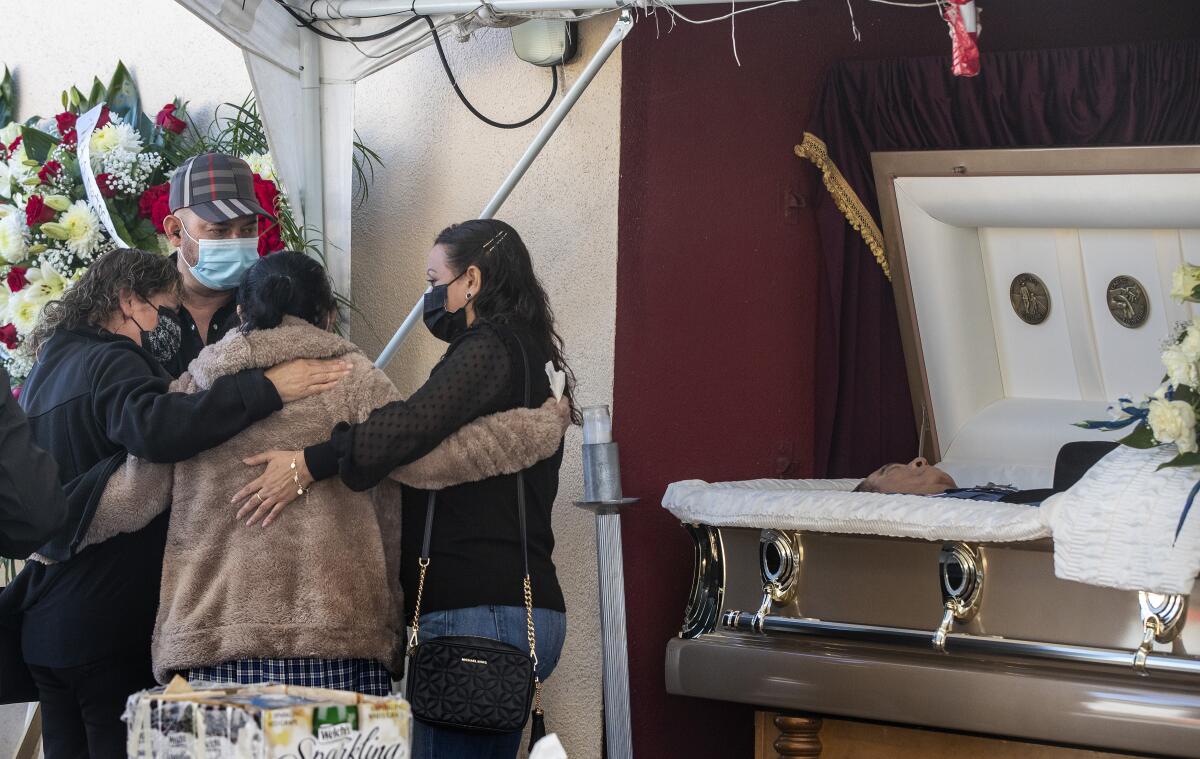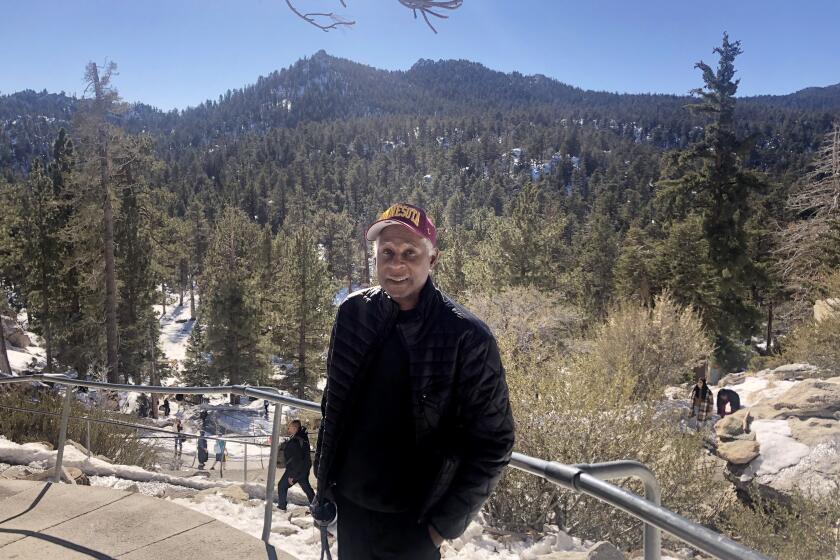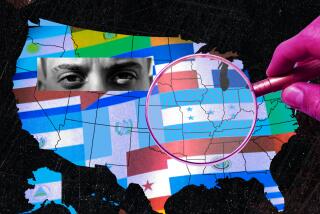Is L.A. witnessing the end of the ‘Latino paradox’?

- Share via
For years, public health experts have observed how Latinos have overall better mortality rates than white residents, despite being more likely to have lower incomes, chronic health issues and decreased access to healthcare.
Now, the historic COVID-19 pandemic has upended the so-called Latino paradox in Los Angeles County.
For the first time in the last decade, the mortality rate for Latinos in Los Angeles County became worse than that of white residents, starting in 2020 — the first year of the pandemic — and worsening the next year.
Latinos also suffered the highest percentage increase in death rates for all reasons among the four racial and ethnic groups analyzed by L.A. County between 2019 and 2021. The mortality rate for Latino residents in L.A. County rose by 48% over that period, growing from a rate of 511 deaths for every 100,000 Latino residents to a rate of 756.
The increase in Latinos’ death rate was double the increase in the death rate for all L.A. County residents, which rose by 23%.
L.A. County officials say that most of the increase in overall deaths is directly related to the pandemic. Health officials estimate that there were about 16,500 additional deaths for all reasons in 2020 compared with the previous year than would otherwise be expected in L.A. County prior to the pandemic. About two-thirds of those deaths were directly blamed on COVID-19.
Dr. Don Garcia, medical director of Clínica Romero, said the numbers should be an alarming call to action.
Garcia argued that the overall numbers for Latinos need to be broken down further to unmask even starker disparities in mortality rates within the Latino population, including for marginalized groups such as “the undocumented immigrants, the uninsured, the ones who don’t have access.”
“Let’s have a public hearing on this. Let’s have a task force on this. Let’s have a regrouping of all the leaders and look at this — just like any type of catastrophic emergency,” Garcia said.
Latinos were not the only group hard-hit by COVID-19.
Black residents have long had the highest death rate in L.A. County, rising during the pandemic from 835 to 1,027 deaths for every 100,000 Black residents. That’s a 23% increase in the mortality rate. Asian Americans’ mortality rate increased by 22%.
The death rate for white residents increased by the smallest amount — 7.6% — from 630 to 678 deaths for every 100,000 white residents.
The calculations were adjusted for age differences among the racial and ethnic groups, are based on provisional data and don’t include L.A. County residents who died outside California.
‘Kept Latinos close’
The Latino paradox concept was hardly an enigma for Boyle Heights resident Carlos Montes.
The Chicano activist witnessed a lifetime of care provided between younger and older generations. Sons bringing their elderly mothers food and hugs, daughters calling and texting fathers, and grandparents rearing their grandchildren were all the norm.
The enduring sense of family “kept Latinos close,” helped elongate lives and offset disadvantages brought about by chronic disease and inflammation.
For many Latinos, those tight-knit familial bonds became a source of risk, as COVID-19 took advantage of the close contact.
The 74-year-old Montes, who lives in an active senior community, said he’s seen friends and neighbors die due to COVID-19 over the last two years. Some tried to stay sheltered in place. But that kind of isolation was just too jarring to maintain.
One of Montes’ close friends, an elderly grandmother, hardly left her apartment, said Montes. The only time she would, he said, it was to visit her sons. COVID-19 claimed her life last year.
“It’s hard to stay locked up and she did a good job, but she probably got COVID-19 on those visits,” Montes said. “That’s all it took.”
Montes said he took a lot of personal precautions, always wearing a mask, practicing social distancing and getting two Moderna vaccine booster shots. But he said many Latinos succumbed to disinformation.
“There was a lot of misinformation being passed around on WhatsApp and that’s where the primos and tías were reading,” Montes said.
Montes remembers being invited to Thanksgiving in 2020 by his girlfriend and her son. It was a gathering of “at least a dozen people,” according to Montes, who declined to participate. The norms of family bonding took their toll as Montes was informed within a week that all who attended the party contracted COVID-19.
“You have to remember, these are Latinos that mostly aren’t working from home,” Montes said. “We work in stores and factories, sell food and clean, and we’re going to run into people.”
He added, “Being essential [workers] really hurt us because we got sick and then spread it our families.”
‘You’re way more vulnerable’
Scholars have been intrigued for decades by the “Latino paradox” — the fact that in the face of high rates of poverty and being uninsured, “you still see Latinos having a much higher life expectancy than would be expected,” said Dr. Michael A. Rodriguez, a professor of community health sciences and family medicine at UCLA.
Researchers have pointed to family support, community cohesion and other social, demographic and cultural factors to try to understand the phenomenon and determine whether it could be harnessed to benefit other groups as well, Rodriguez said.
In recent years, the Latino paradox began showing signs of eroding, with some data suggesting it started before the pandemic, he said.
Nonetheless, there have still been consistent findings and projections — prior to the pandemic — that Latinos were expected to have a relatively long life expectancy.
According to a report discussing the Latino paradox and published in 2015 by the U.S. Centers for Disease Control and Prevention, Latinos had a 24% lower overall death rate compared with white residents, even though Latinos were more likely to live below the poverty line, not to have completed high school and to have decreased access to healthcare.
The pandemic has affected Latinos from all walks of life, attacking their families, their health as well as their financial well-being. The impacts will be felt for generations, and have implications for all Californians.
A far greater percentage of Latinos lacked health insurance — about 42% — compared with 15% of white residents.
Latinos had lower mortality rates caused by cancer and heart disease than white residents, the CDC said. Latinos were less likely to report that they smoked.
“Lower smoking rates among Hispanics, immigration of healthy immigrants, reverse migration of more ill or elderly immigrants, and higher levels of family support might help to explain this mortality advantage for some Hispanic origin groups,” the CDC report said.
Latinos did have higher death rates than white residents for diabetes, homicide, chronic liver disease and cirrhosis.
Federal researchers have found that being born in the U.S., and staying longer here, is associated with poorer health outcomes.
Dr. Efrain Talamantes, chief operating officer for AltaMed Health Services, suggested that the “Latino paradox” in mortality has been tied to the healthier environments that many Latin American immigrants have grown up with before coming to the U.S., the salutary effects of which then fade over time and generations.
That kind of protection “doesn’t apply when it’s a disease that is passed on through people,” like COVID-19, he said. And because Latinos made up a disproportionate number of workers who couldn’t work from home and live in households with many other people, they were more exposed to the virus than others.
To make matters worse, many Latinos with chronic conditions had their medical care interrupted during the pandemic.
“What we’re seeing now is, there’s a lot of patients showing up that haven’t been taken care of for the last year or two,” Talamantes said. “They have worsening of their diabetes. Worsening of their hypertension.” That makes them more vulnerable to grave illness from COVID-19, he said.
As a physician practicing in Boyle Heights, he has seen families lose grandparents, then parents, to devastating effect.
“The number of families impacted by losing a family member who at some point was providing care or was bringing in income to the household has been astronomical,” Talamantes said.
More and more patients started showing up worried about their ability to pay for groceries, rent and bills.
Marissa Evans’ father began 2022 eating apple pie and feeling like it would be their family’s year. He died of COVID-19 before the end of January.
‘Whole village approach’
Chinatown resident Raul Claros, 41, said despite its size and influence, the Latino community of Los Angeles is as dependent on the individual as it is the whole.
“We take care of each other’s families because we migrated here together and brought our families here to live,” said Claros, who is of Salvadoran and Costa Rican descent. “It’s the whole village approach.”
This closeness between generations of families sharing one home, having their children studying and playing in proximity, and of shared labor helped Latinos survive for generations, contended Claros. But the same factors that made the Latino paradox possible also gave oxygen to a viral disease that preyed on human contact.
“The ... village got blown up in 2020,” said Claros, who co-founded the Reimagine LA Foundation, an organization dedicated to building community leaders. “The kids survived but the grandparents died.”
Claros’ father had been successfully treated for stomach and colon cancer for two years and “was doing great,” to the point where doctors were discussing remission. He was diagnosed with COVID-19 on Dec. 23, 2020, the younger Claros’ birthday, and intubated on Dec. 27.
Before the pandemic, visits from family members helped sustain Claros Sr. as he fought against cancer. After COVID-19 showed up, the challenge became how to maintain a safe distance from his dad, the younger Claros said. It was an emotionally hard thing to do.
Nevertheless, on Feb. 13, 2021, his father died from complications from COVID-19 and cancer. He was 64.
“It hit him and took him out quick,” his son said. “It was a seven-week process, but it also felt like forever at the same time.”
More to Read
Sign up for Essential California
The most important California stories and recommendations in your inbox every morning.
You may occasionally receive promotional content from the Los Angeles Times.



















